Raksha Upreti1*, Pratima Poudel2, Dipendra Aryal3, Kiran Kumar Gupta4
1Himalayan College of Agriculture Sciences and Technology, Salyanthan, Kritipur Kathmandu, Bagmati Province, Nepal
2Himalayan College of Agriculture Sciences and Technology, Salyanthan, Kritipur Kathmandu, Bagmati Province, Nepal
3Agriculture and Forestry University, Rampur, Chitwan, Nepal
4Agriculture and Forestry University, Rampur, Chitwan, Nepal
*Corresponding Author: Raksha Upreti, Himalayan College of Agriculture Sciences and Technology, Salyanthan, Kritipur Kathmandu, Bagmati Province, Nepal.
Received: September 09, 2024; Published: September 28, 2024
Citation: Raksha Upreti., et al. “Knowledge, Perceptions and Practice of Pesticide Use Among Vegetable Growers in Rapti Municipality, Chitwan, Nepal". Acta Scientific Agriculture 8.10 (2024): 133-140.
A field study was conducted to assess knowledge of pesticide use among vegetable growers during the months of October 2020–January 2021 in Rapti Municipality of Chitwan District. Thirteen wards of Rapti Municipality were purposefully selected for the study. A total of 104 households, 8 from each ward, were selected by simple random sampling. Primary data were collected through interviews with semi-structured questionnaires, a key informant interview, and a focus group discussion within the study site. Secondary data were collected from various publications of MoALD, various world-wide non-governmental organizations, and journals of universities. The study revealed that 100% of the population had general knowledge of pesticides. Most of the farmers used pesticides for insect and disease control rather than weed or rodent control. 51% of farmers read the level on the package. 56.7% followed the instructions given on the label. About 40.4% were aware of the toxicity level in general. About 62.5% were aware of the waiting period for vegetables, but fewer farmers followed the practice of waiting periods. 80.8% of farmers considered wind direction during pesticide application. 32.7% of farmers were hospitalized after the health risk caused by pesticide spray. Only 13.5% were aware of the banned pesticides. 63.5% had an idea about IPM, but only 4.8% considered protection of natural enemies. About 27.9% knew about the residual effects of pesticides. Only 9.6% of farmers had attended training on safe pesticide use.
Keywords: Disease; Pest; Health Risk; Pesticide; Vegetable
Nepal is an agrarian country, with agriculture as the major occupation of 66% of the total population. Despite the practice of subsistence farming, agriculture comprises about 27% of the gross domestic product (GDP) [1]. In the late 1980’s, it was the livelihood for more than 90% of the population; although only approximately 20% of the total land area was cultivable, it accounted for, on average, about 60% of GDP and approximately 75% of exports [2].
Fresh vegetable production is a prominent agricultural vocation in Nepal's road-accessible Terai and mid-hills regions. Road accessibility, irrigation facilities, and a favorable market outlook are the key reasons driving the rise of fresh vegetable farming areas in and around the country's urban areas [3]. The trading data for vegetables is 166 million rupees, and the import value of vegetables is 3,301 million rupees, comprising a trade deficit of 3,135 million rupees in vegetables [4].
Among the several factors contributing to low agricultural productivity, the high incidence of disease and pests and the emergence of new alien and invasive species were identified as major factors [5]. In Nepal, the total loss incurred by diseases and pests amounts to 25–35% of total losses [6]. Two hundred and eleven metric tons of pesticides are imported annually in Nepal: fungicides (61.38%), insecticides (29.19%), herbicides (7.4%), and others (2%) [7]. The gross sales and values account for US $3.05 million per year [8]. Of the 107 different pesticides, based on the WHO risk classification system, 2 (1.87%) are highly hazardous (WHO class Ib), 39 (36.44%) are moderately hazardous (class II), 19 (17.75%) are slightly hazardous (class III), 45 (42.06%) are low risk (class U/NH), and 2 (1.87%) were not calculated. None of them is extremely hazardous (IA) [7]. More than 90% of the pesticides imported into the country are used in vegetable farming [9].
The site selected for the survey was Rapti Municipality in Chitwan District. Rapti municipality comprises 13 wards. The study was conducted at the Rapti Municipality of Eastern Chitwan, covering an area of 212.46 sq. km. It is situated at a latitude of 27.641520N and a longitude of 84.618250E (Figure 1). It is connected to Makwanpur district in the east, Khairahani municipality of Chitwan district in the west, and Dhading district along the Mahabharat chain in the north. The southern part of the municipality is connected to Chitwan National Park. The climate of the Rapti Municipality area is characterized by a warm and sub-tropical climate. The temperature rises to 40 °C from March to June. The average temperature of 25 °C is experienced from October to February. The annual average precipitation of the study area is 1955 mm [10].
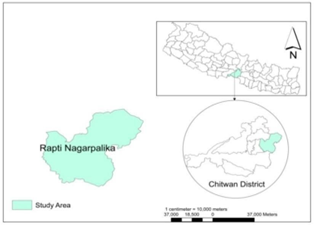
Figure 1: Study site.
A total of 104 vegetable farmers and 10 pesticide retailers were interviewed using a semi-organized poll. The meeting was done determinedly without going astray from the targets of the investigation and considering the restricted time span of the examination. The complete number of active and progressive vegetable farmers was the population of study. Field visits were completed a few times to become acquainted with prominent features of the study site, for example, land use, geography, infrastructure, government/non-taxpayer-driven organization suppliers, and nearby clubs and associations. Pre-testing of the poll was finished by looking over 10 farmers (close by the study site) to assess their legitimacy and adequacy and to understand farmers’ attitudes towards pesticide use, knowledge, and practices. The questionnaire was further subdivided into three major headings: 1) Socio-demographic status 2) Framer’s knowledge and perceptions regarding pesticide use; and 3) Pest management practices among vegetable growers. The individual farmers were personally visited and interviewed face-to-face, except in Ward No. 13, as the roadways were under construction and transportation was not possible.
All the collected data were scrutinized and refined before analysis. A descriptive statistic and frequency distribution analysis were conducted among all the parameters obtained. A Chi-square test was used to determine an association between parameters such as training received on vegetable farming, pesticide use pattern, exposure, and other qualitative variables (p < 0.05). The software IBM SPSS Statistics 20 and MS Excel were used for data analysis.
The average age of the household head was 47.22 years, whereas the average age of the respondent was 41.77 years. The average schooling of the respondent was 5.50 years. The average family size was 5.83. Most respondents were in the age group 42–54, followed by 30-42, above 54, 18–30, and below 18 (Table 1). In comparison to older farmers, the involvement of younger farmers (under 40 years old) in vegetable production provides significant hope for training new and safer pest management approaches (Damalas and Hashemi, 2010). Of the surveyed farmers, 38.5% had a primary level of education, followed by illiterate (22.1%), secondary level (15.4%), lower secondary (12.5%), higher secondary (7.7%), bachelor (2%) and masters (1%). More than 70% of the population considered agriculture a major source of income. More than 50% of farmers had land holdings of less than 10 katha.
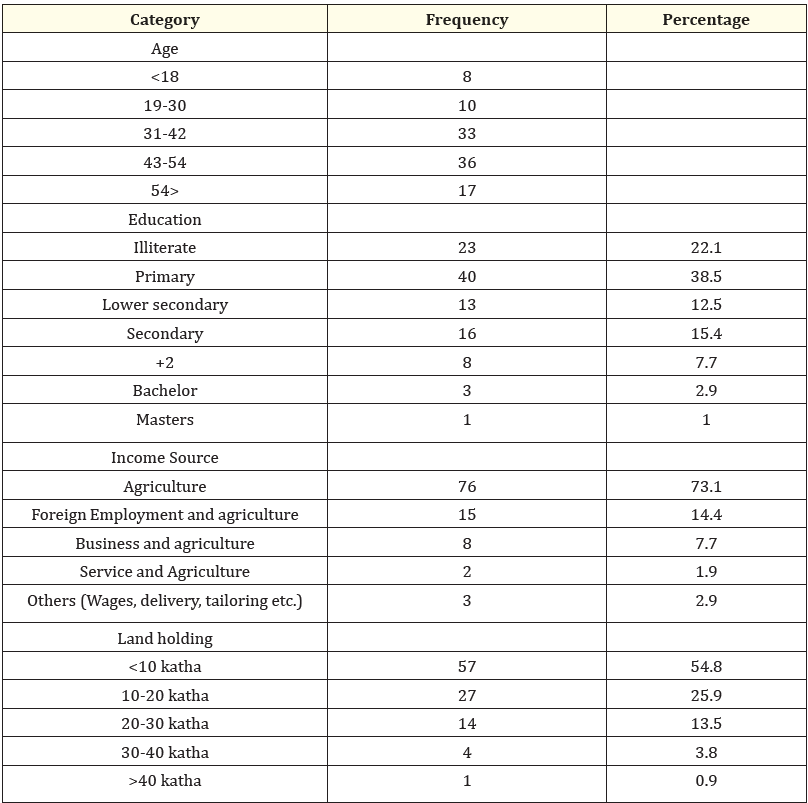
Table 1: Demographic and socio-economic status.
In the overall sample of vegetable farmers surveyed, 79.8% used chemical methods and only 1.9 farmers used biological methods. Out of 104 vegetable farmers surveyed, 40.4% applied pesticide after seeing major damage, 38.5% applied pesticide just after pest appearance, 13.5% applied either before or after pest appearance, 5.8% applied before pest appearance, and 1.9% applied after recommendation by neighbors. Most farmers' prophylactic spraying may be due to a lack of understanding and information regarding insect biology and economic thresholds. Pesticide applications made before the presence of pests in the field result in wasteful costs [11] and pesticide misuse.

Table 2: Current pest management practices among vegetable growers in Rapti Municipality, Chitwan, Nepal.
Farmer’s perception about pesticide uses and it effect on environment and human health.
Farmers perception of pesticide effects on field ecology
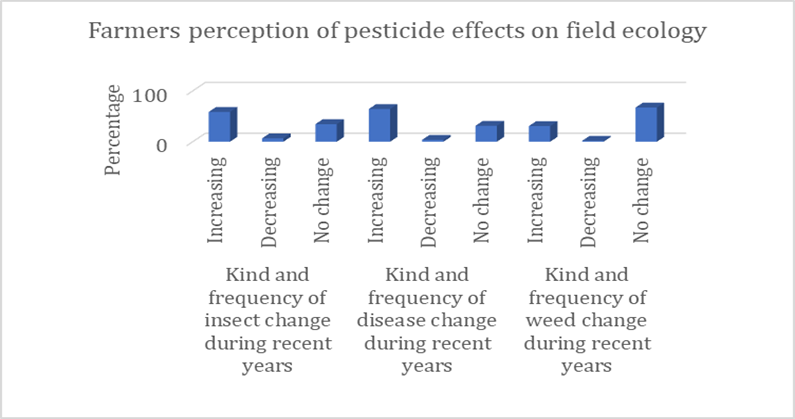
Figure 2: Farmers perception of pesticide effects on field ecology.
When the farmers were asked about the changes in the kind and frequency of insect, disease and weed in recent years, 58.7%, 64.4% and 30.8% respectively noticed the increasing trend. Very few farmers noticed the decreasing trend. Insect damage is one of the main problems in vegetable production. A filed survey in Katsina State, Nigeria revealed that the tomato had the highest (30.47%) prevalence, while onion had the least (5.42%) pest prevalence [12].
Farmers perception of pesticide effects on environment

Figure 3: Farmer’s perception of pesticide effects on environment.
Overall, 78.8% (82), 71.2% (74), 76.9% (80), and 76.9% (80) of respondents agreed on the term that pesticides were affecting soil, bees/pollinators, air, and rivers/streams, respectively. When pesticides escape from production sites and storage tanks, flow off from fields, are discarded, or are aerially sprayed and poured into water to kill algae, they contaminate land and water [13]. According to the WWF, since the 1970s, the increased occurrence of sickness, malformations, and tumors in commercial fish species in highly polluted parts of the North Sea and coastal waters of the United Kingdom is consistent with consequences known to be induced by pesticide exposure [14].
Farmers perception of pesticide effects on human health

Figure 4: Farmers’ perception of pesticide effects on human health.
Out of 104 respondents, 100 (96.2%) respondents reported that pesticides have health impacts. 34 (32.7%) of them were found to have health problems while spraying the pesticide, and only 5 (4.8%) of them had been hospitalized. In Nepal, nearly 51% of farmers had an acute pesticide poisoning syndrome, and one out of every ten farmers had multiple chronic ailments, with 24% of farmers having chronic neuropathic diseases [15].
More than half of the population (50.9%) applied the pesticide randomly per season. Although the frequency of pesticide application varies depending on the insect and crop being targeted, the survey's goal was to acquire generic baseline data and a trend. A similar conclusion was made in Bhaktapur, Nepal, where most farmers use pesticide four times every season, regardless of pest infestation (Jha and Regmi, 2009). The average number of times pesticides were applied per year ranged from 8 to 50. According to Nepal (2010), farmers spray pesticides 15 to 35 times during one crop cycle [16]. More than half (53.9%) of the farmers collect their vegetables within 0–4 days of pesticide application. A similar trend was also seen in Dhading district of Nepal, in which more than half (53.3%) of the farmers picked vegetables in the interval of 0–4 days of pesticide spray [17]. A very small percentage of farmers (4.8%) followed the actual waiting period. More than forty percent (43.3%) of farmers knew well about the biological method of pest control. Most of the farmers, 47.1% of people in Rapti Municipality use PPE while spraying. As it was the time of the COVID-19 pandemic, it helped to become more careful. Even though farmers were aware of the detrimental consequences of improper pesticide usage, there was no significant link between awareness and the implementation of preventative measures [11].
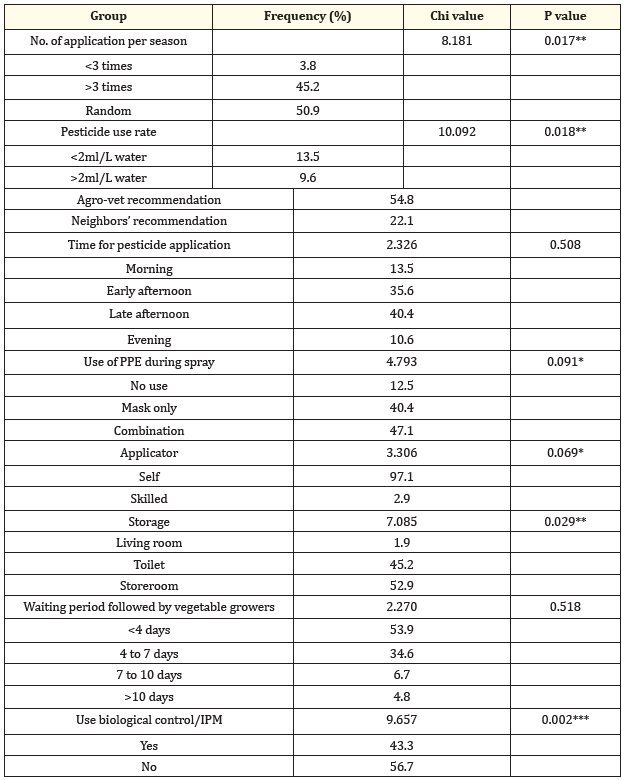
Table 3: Pesticide use pattern in Municipality.
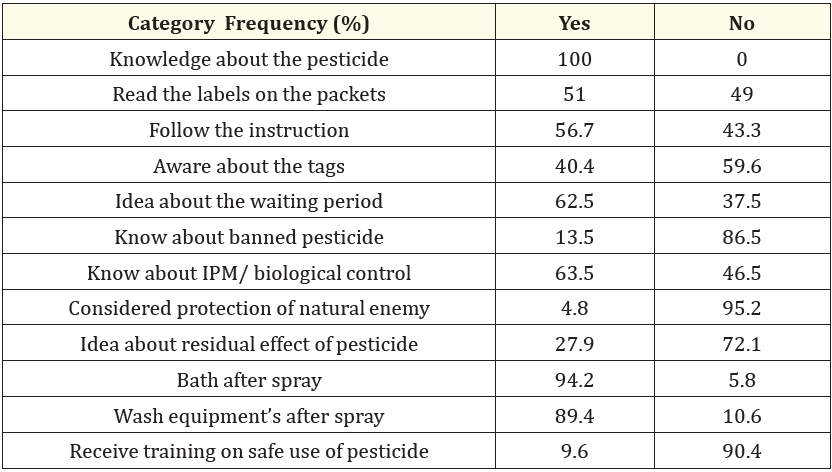
Table 4: Know ledge and awareness of pesticide use by municipality.
For safe pesticide handling, reading the label and following the instructions during application are most important. Most farmers (100%) were aware of pesticides' potential side effects. But only half of the farmers (51%) read the labels on the packet and follow the instructions given on the packets. Most of the farmers (62.5%) were aware of the waiting period. Very few (13.5%) of farmers were aware of the banned pesticide. The practice of maintaining personal hygiene decreases the risk of health hazards. 40.4% of farmers were aware of the color tags, which is a quite satisfying result compared to 94.4% of them who take a bath, and 89.4% of them wash the equipment after pesticide spray, which is a very good practice. A similar case was also seen in Dhading district, where more than 90% of farmers maintain personal cleanliness right after spraying [17]. But less than ten percent (9.6%) of farmers have taken training on the safe use of pesticides in the municipality. When we see the whole Chitwan district, only 17% of the vegetable growers have taken training on safe pesticide use [18].
In terms of farmer understanding of integrated pest management (IPM), 63.5% of farmers were aware of IPM. And 43.3% were adopting the method of IPM in their field. But in a survey done in 2017, only 14% of vegetable growers were found to use the IPM method of pest control [18]. About 71% (Fig. 2) were aware of the pesticide effects on beneficial insects like bees, but only 4.8% considered the protection of natural enemies (Table 4). During pesticide spraying, most farmers (95.2%) (Table 4) did not take any procedures to prevent pesticides from harming non-target beneficial insects and pollinators. Only 9.6% of them had received training on safe pesticide use, which is very poor. This scenario clearly demonstrated the need for community or other forms of IPM initiatives to provide information and training to farmers and government personnel [11,19].
The authors would like to acknowledge Agriculture and Co-operative Development Section, Rapti Municipality and people of Rapti municipality for providing platform and supports during my study.
Copyright: © 2024 Raksha Upreti., et al. This is an open-access article distributed under the terms of the Creative Commons Attribution License, which permits unrestricted use, distribution, and reproduction in any medium, provided the original author and source are credited.